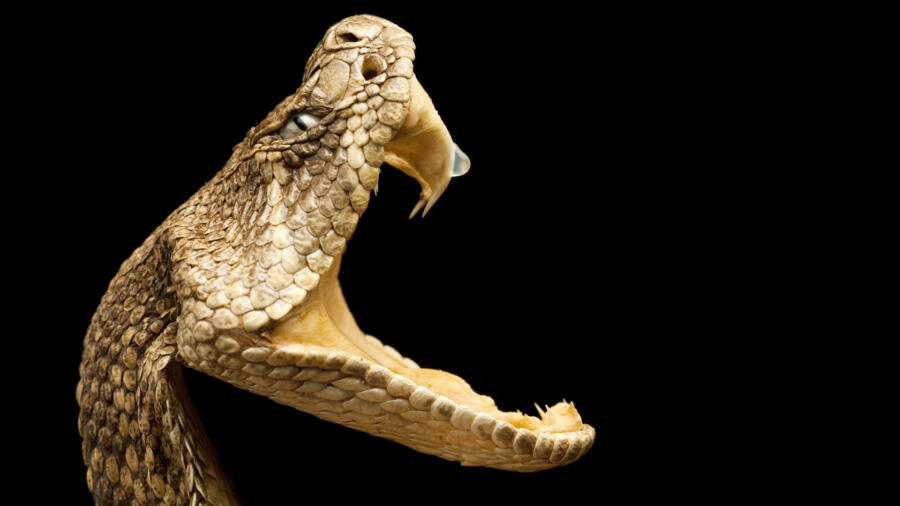The following content contains disturbing accounts of violence. Discretion is advised.
In ancient Rome, those found guilty of certain crimes often faced a brutal form of execution called damnatio ad bestias or “condemnation to beasts.” Before cheering crowds of onlookers, inside the Coliseum and other public venues, convicted criminals were pitted against or fed to animals. This form of capital punishment also provided a macabre form of entertainment.
Although most uses of animals as weapons are no longer lawful, that hasn’t stopped some people from using “beasts” to kill on their behalf. A&E True Crime looks at notorious examples of murders aided by animals.
Raymond Lisenba (Robert ‘Rattlesnake’ James)
In the summer of 1935, a Los Angeles man Robert “Rattlesnake” James, also known as Raymond Lisenba, acquired two rattlesnakes from an exotic pet dealer. But “Lethal” and “Lightning” would not be kept as pets. James had concocted a plan to cash in a $5,000 insurance policy he had taken out on his pregnant wife Mary.
On August 4 of that year, with the help of an accomplice, Charles Hope, James tied Mary to a kitchen table and forced her left foot inside a box containing the snakes. Although the rattlers bit her three times, the venom did not prove lethal. The next day, James finished the job by drowning his wife in the bathtub.
Mary’s body was discovered next to a fishpond behind their house. Her death was initially declared an accidental drowning, but then Hope began to speak out. Officials exhumed Mary’s body and discovered fang bites on her foot, matching Hope’s statements. James was convicted of first-degree murder and sentenced to death in July 1936. On May 1, 1942, he became the last person executed by hanging in California.
Henry Thomas
When the Royal Canadian Mounted Police began investigating the death of 2-year-old Aleka Esa-Bella Scheyk Gonzales in May 2014, they suspected her mother’s boyfriend, Henry James Thomas, might be involved. Thomas told investigators in North Vancouver, British Columbia that the child had fallen down the stairs while under his care, but testing later revealed the shocking truth. Gonzales died from snake venom that Thomas had injected into the child.
“The reasons people (mostly men) keep these dangerous animals as ‘pets’ is quite varied, ranging from simple interest and fascination to morbid and machismo attitudes. Thomas was one of these [latter cases], and he seemed to believe in that tired adage ‘what doesn’t kill you makes you stronger’,” says Steve Mackessy, a snake expert and biology professor at the University of Northern Colorado who helped identify that venom was used to poison Gonzales. “Apparently, [Thomas] believed that by injecting small amounts of venom, he could ‘improve his immune system,’ a sentiment that is at least in part shared by another bizarre group of people…those that ‘self-immunize’ or inject themselves with venoms to provide immunity to venomous snakebites.”
Mackessy’s testing revealed a cumulative amount of venom that would have proven lethal to an adult, let alone a small child. It’s unknown how long Thomas might have been injecting venom into Gonzales. Mackessy tells A&E True Crime that it could have been small doses over time, or possibly one acute large dose.
Thomas received an 18-month jail sentence on December 18, 2019 for failing to provide Gonzales the necessities of life.
Robert ‘Willy’ Pickton
In 2002, a former pig farm in British Columbia became the site of one of the largest crime scenes in Canadian history. For more than a decade, serial killer Robert Pickton lured women—mainly sex workers and drug addicts from Canada’s indigenous community—onto his property and then murdered them. He boasted about grinding some of the bodies into mince that was fed to his pigs and possibly mixed with pork and sold for human consumption.
In December 2007, a jury found Pickton guilty of six counts of second-degree murder, carrying a life sentence with no possibility of parole for 25 years. Evidence recovered at the scene revealed the DNA of 33 women, but while in prison, Pickton told an undercover agent that he had killed 49 women and “wanted one more to make the big five-O.”
Susan Monica (‘Sweetest Murderer’)
Susan Monica admitted that she preferred animals over people. “I do not value human life very much,” Monica said in taped confessions. “My feeling is the only thing wrong with the planet is there’s people on it. If not for us, all the other animals, even dodo birds, would be here.”
A jury weighed Monica’s admission before convicting the former farmer of killing 59-year-old Stephen Delicino and 56-year-old Robert Haney and feeding their corpses to her pigs. Both men disappeared in 2012 and 2013, respectively, after Monica hired them as handymen on her 20-acre farm in Wimer, Oregon.
According to a state anthropologist who testified at the trial, Haney’s legs had been chopped off with an ax, and the thigh bones showed signs of being chewed by an animal. Some of Delicino’s remains were found in plastic bins in Monica’s barn when her residence was searched in 2014.
On April 27, 2015, a judge sentenced Monica to a minimum of 50 years in prison.
Chrisdian Johnson
Sixteen-year-old Oluwaseyi “Seyi” Ogunyemi didn’t stand a chance when a pit bull cross named Tyson brought him to the ground in Larkhall Park, Stockwell, South London and began mauling him. The dog’s owner, rival gang member, Chrisdian Johnson, then stabbed Ogunyemi six times, while a second dog went after several of Ogunyemi’s friends.
“At the time of the attack (in April 2009), both dogs were unleashed, and chased and then brought down and savaged their victims, giving their human masters an advantage, enabling them then to access their victims in order to stab them with knives,” Brian Altman, prosecuting attorney in the case, told jurors.
DNA technology proved a billion-to-one probability that some of the blood came from Tyson. “It was a pioneering case and possibly the first time dog DNA had been used,” Altman tells A&E True Crime.
At sentencing, Judge Christopher Moss told Johnson, “You used two fearsome weapons. The first was your pitbull [mix] dog, which I have no doubt you had trained to attack and bring down your prey. The second was the knife with which you stabbed Seyi Ogunyemi to death.”
Johnson was given a life sentence on March 19, 2010 with no possibility of parole for 24 years.
Richard Kuklinski (‘The Iceman’)
Richard Kuklinski garnered the reputation as being one of America’s most ruthless hitmen, working on behalf of several organized crime families including the Gambinos and Genoveses. He earned the nickname “The Iceman” for the way he froze bodies to disguise the time of death and throw law enforcement off his trail.
Although he was convicted of multiple murders—spanning from 1998 to 2003—and given two consecutive life terms, while incarcerated Kuklinski claimed to have killed more than 200 people. One grisly account was that he fed several people to rats while they were still alive.
Retired ATF special agent Dominick Polifrone conducted an 18-month undercover operation that led to the capture and arrest of “The Iceman.” Polifrone tells A&E True Crime that during one of their meetings Kuklinski mentioned filming someone being eaten alive by rats, but there was no proof and the so-called video footage was never found. Nonetheless, Polifrone maintains “The Iceman” had it in him to commit such a heinous crime.
“He was an evil son of a bitch. He would laugh about how he murdered people,” says Polifrone. “I called him the devil. He was the devil.”
Kuklinski died of cardiac arrest on March 5, 2006.
Related Features:
First They Tortured Animals, Then They Turned to Humans



